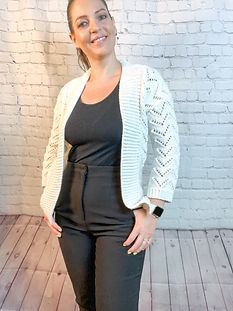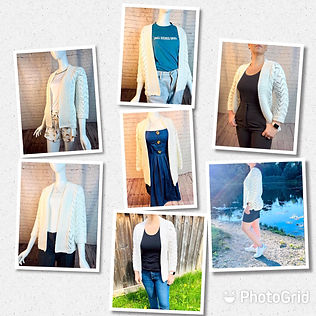
All of my cardigans have buttons, and I hate sewing on buttons. What is the solution for this problem? Open Cardigan!!!!
It's summer so lace pattern is the way to go for a nice cardigan.
Next question: colour? I love light colours in spring/summer and I have a very few white garment, so it was obvious for myself that I need some white yarn.
The last question: material?
In the summer my go to material is cotton (or cotton blend), bamboo.
This yarn is very soft, not thin but not too thick so that's why I decided to make the cardigan with this material: Loops&Threads Capri (57% cotton, 28% nylon, 15% polyester). This material is also so bouncy, you can stretch it real good, but it bounces back.
The Summer Cardi is worked from the bottom up in sections, starting with the back panel. There are 5 panels you have to attach together: Back and front (2) panels and the sleeves (2); and finally the collar is made at the end. You can find many videos on YouTube on "how to seam a knit sweater", if it's your first project with seams, pls check a few video tutorials out. If you take a look at the last photo, you can see that the seaming is perfect, the pattern is perfectly align with each other. Why? Because of the k1 edge stitch at the beginning of the rows.

For best result, use the same material as I used
XS/S: 500g/800m, 17.5oz/870yds
M/L: 574g/918m, 20oz/1000yds
XL/2XL: 669g/1070m, 24oz/1171yds
Needles: 5mm (US8) and 4.5mm (US7) circular needles
Other: Tapestry needles, scissors, tape measure
Gauge: 17 sts and 25 rows = 10cm x 10cm (4" x 4”) in a lace pattern swatch.
Your blocked pieces (back/fronts/sleeves) might be a little different in sizes (measurements), because we all have different tensions. (If you get too many stitches in 4" change to a larger needle size. If you get too few stitches in 4", change to a smaller needle size.)
What size should I choose?
I wanted my cardigan to be a little snug, so even though my dress size is S/M, I went for the size XS/S for this project. I could have made the front panels with size M/L for a less open design (with the back panel size XS/S), but my goal was an open style. You can make the cardigan longer by continuing with the lace pattern, and of course you can make the sleeves longer with the lace pattern.
You can also make the side/neck band wider or narrower. There are many options for you, you can be your own designer!
Here's another blogpost for helping with your sizing: https://www.erikadesigncanada.com/post/what-size-should-i-choose-from-a-knit-crochet-pattern
How to style it?

I use my cardi for every occasion, in the office, for a date night with my husband, when I'm running errands; with jeans, with skirt, with dresses, and after I wake up in chilly mornings. The possibilities are endless.

Hope this short blog post helps you with your Summer Cardi!
Don't forget my FB group (Erika Design - Knitting tutorials and more), so I can help you with knitting/crochet questions you might have.
Pls tag me on Social Media when you make something after checking my tutorials/blog/patterns: https://linktr.ee/ErikaDesign

Links to the pattern:
Ravelry:
Etsy:
Thank you for reading!

Comments
Post a Comment